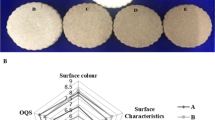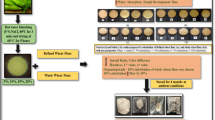Abstract
Low Glycemic Index (LGI) foods help to maintain blood glucose level in diabetic individuals. Pea flour (PF) is known to be one of LGI ingredients used in the food industry. To assess the influence of PF in noodle processing, thermally processed pea flour was incorporated at 20 % and 40 % in the preparation of noodles using Lab scale Noodle Making Machine. Evaluation for Physico-chemical, rheological and noodle making characteristics, in vitro starch digestibility (IVSD) and microstructure of noodles were carried out. Cooking quality did not show any significant difference among the samples, with solid leach out ranging from 6.7 to 7.2 % against control (6.5 %). Colour measurement showed the presence of greenish colour in PF incorporated samples. Texture was firmer in fresh noodles (FN) (5.52 Newton (N), 6.00 N) and dried noodles (DN) (7.60 N, 7.86 N) compared to control (4.38 N-FN, 6.88 N-DN). Sensory analysis of noodles revealed that the samples (FN, DN) were acceptable at 20 % and 40 % levels with overall quality score (>8.5). In vitro analysis revealed that with increase in PF content there was a significant decrease in the availability of glucose in DN followed by FN compared to control. Overall RDS was reduced and SDS was increased in 40 % PF incorporated FN. Scanning-electron microscopy revealed the presence of fiber matrix around the starch granules.






Similar content being viewed by others
References
American Association of Cereal Chemists (AACC), Approved Methods of the AACC, 10th ed (2000) AACC Method 44-15A, One Stage Moisture Air Oven Method; AACC Method 08–01, Ash–Basic Method; AACC Method 46–13, Micro-Kjeldahl Method; AACC Method 22-10A; AOAC 991.43; Dietary fiber, AACC Method 16–50; Pasta Cooking Time- 66–50, AACC, AACC 2, method 54–21 American Association of Cereal Chemists, St. Paul, Minnesota
Association of Official Analytical Chemists (AOAC) (1984) Official methods of analysis, 14th edn. Washington, DC, USA
Bahnassey Y, Khan K (1986) Fortification of spaghetti with edible legumes II rheological processing and quality evaluation studies. Cereal Chem 63:216–219
Bozzini A (1988) Origin, distribution and production of durum wheat in the world. In: Fabriani G, Lintas C (eds) Durum chemistry and technology. American Association of Cereal Chemists, USA, pp 1–16
Cavazza A, Corradini C, Rinaldi M, Salvadeo P, Borromei C, Massini R (2012) Evaluation of pasta thermal treatment by determination of carbohydrates, furosine, and color indices. Food Bioprocess Technol. doi:10.1007/s11947-012-0906-6
Dalbon G, Grivon D, Pagani MA (1996) Pasta: continuous manufacturing process. In: Kruger JE, Matsuo RB, Dick JW (eds) Pasta and noodle technology. American Association of Cereal Chemists, St. Paul, pp 13–58
Dilawari JB, Kamath PS, Batta RP, Mukewar S, Raghavan S (1981) Reduction of postprandial plasma glucose by Bengal gram dal (Cicer arietinum) and Rajmah (Phaseolus vulgaris). Am J Clin Nutr 34:2450–2453
Duncan BD (1955) Multiple range and multiple F-tests. Biometrics 11:1–42
Englyst HN, Kingman SM, Cummings JH (1992) Classification and measurement of nutritionally important starch fractions. Eur J Clin Nutr 46:S33–S50
Hutchings JB (1994) Food color and appearance. Chapman and Hall, Blackie Academic and Professional, Great Britain and London
Indrani D, Soumya C, Rajiv J, Rao GV (2010) Multigrain bread—its dough rheology, microstructure, quality and nutritional characteristics. J Texture Stud 41:302–319
Miller JCB (1994) Importance of glycemic index in diabetes. Am J Clin Nutr 59:747S–752S
Nuttall FQ, Mooradian AD, Gannon MC, Billington C, Krezowski P (1984) Effect of protein ingestion on the glucose and insulin response to a standardized oral glucose load. Diabetes care 7(5):465–470
Prabhasankar P (2002) Electrophoretic and immunochemical characterization of wheat protein fractions and their relationship to chapati making quality. Food Chem 78:81–87
Prabhasankar P, Ganeshan P, Baskar N (2009) Influence of Indian brown seaweed (Sargassum marginatum) as an ingredient on quality, bio-functional and microstructure characteristics of pasta. Food Sci Technol Int 15:471–479
Stone H, Sidel J, Oliver S, Woolsey A, Singleton RC (1974a) Quantitative descriptive analysis, development, application and the future. J Food Technol 58(8):48–52
Stone H, Sidel J, Singleton RC (1974b) Sensory evaluation by QDA. J Food Technol 28(11):24–34
Susanna S, Prabhasankar P (2011) A comparative study of different bio-processing methods for reduction in wheat flour allergens. Eur Food Res Technol 233:999–1006
Tudorica CM, Kuri V, Brennan CS (2002) Nutritional and physicochemical characteristics of dietary fiber enriched pasta. J Agr Food Chem 50:347–356
Uthayakumaran S, Wrigley CW (2010) Wheat: characteristics and quality requirements. In: Wrigley CW, Batey IL (eds) Cereal grains assessing and managing quality. Woodhead publishing limited, New Delhi, pp 59–111
Wild S, Roglic G, Green A, Sicree R, King H (2004) Global prevalence of diabetes: estimates for 2000 and projections for 2030. Diabetes Care 27(5):1047–1053
Acknowledgments
The author BKS thanks Council of Scientific and Industrial Research (CSIR), New Delhi for the grant of senior research fellowship and also thanks CSIR-CFTRI for providing me the necessary facilities to carry out this research work.
Author information
Authors and Affiliations
Corresponding author
Rights and permissions
About this article
Cite this article
Bharath Kumar, S., Prabhasankar, P. A study on noodle dough rheology and product quality characteristics of fresh and dried noodles as influenced by low glycemic index ingredient. J Food Sci Technol 52, 1404–1413 (2015). https://doi.org/10.1007/s13197-013-1126-4
Revised:
Accepted:
Published:
Issue Date:
DOI: https://doi.org/10.1007/s13197-013-1126-4




